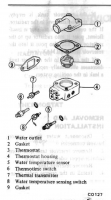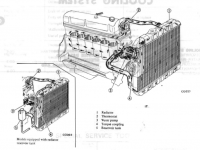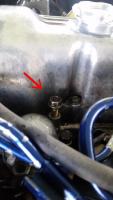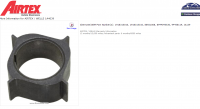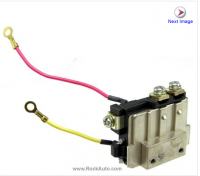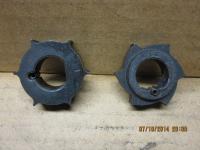Everything posted by Zed Head
-
Too many problems to list...
Is this while idling? The small details can have a big impact with these engines. Vacuum leaks are a big problem. You can't really do any tuning at all if youhave vacuum leaks. Also, just the simple basics like getting your ignition timing right, and adjusting valve lash are important. Basic steps before you get carried away. People have spent lots of effort on the wrong things, then found that something basic wasn't set right. There's am Engine Tuneup chapter in the FSM. Do the steps in order and you'll be way ahead.
-
Too many problems to list...
As I said, he was either BS'ing you by grabbing a loose screw and turning it or you mistook the one he actually turned for that one. Attached a picture showing the screw position that I think we're talking about. Also noticed that your radiator does not appear to be stock. Could be too small for the engine but certainly a sign of a past cooling problem. These pictures are from the Cooling chapter. An example of what you'll find in the books. The digital FSM's are one of the great benefits of owning these cars. You don't have to try to communicate with the parts store guys. Looks like you have a challenge. Keep posting, everybody loves a good puzzle. Edit - just noticed that you seem to have an electric fan, guessing by the shroud. Another not really necessary "performance" item. If the fan isn't coming on you'll have over-heating problems at slow or no speed.
-
Too many problems to list...
I put an arrow on your picture. That bolt has nothing to do with any of that. Maybe he was pointing at another? But, there is no adjustment that will, normally, make the engine idle better, but cause a power loss. That would only be the case if things were messed up. Your best bet is to assume the guy you bought it from was a BS'er or didn't know what he was doing. The taped up intake hose, the shiny new oil filler cap, red plug wires, painted air box, 4" exhaust tip - all things that cause pause. Describe one problem at a time and people here can walk you through some of them. I would focus on over-heating first. One overheat can blow your head-gasket and/or warp the head. That's a major expense, and a fairly difficult DIY job. Back to watching Holland beat up on Brazil....
-
Too many problems to list...
There should be a spring under the throttle body (at the end of that linkage) that closes the throttle blade. It might be missing, they break sometimes. It's hard to see, it's underneath. If you haven't yet, open the Engine Fuel chapter from EuroDat's link in Post #2 and look through it. You'll get a better idea of how things work. You've got some study ahead of you though. If you have a multimeter be ready to break it out and start probing. Here's another good link for the FSM's if you don't have an unzipping program. Index of /FSM/280z
-
Too many problems to list...
That is a very important tube (aka hose). It needs to be leak-free.
-
Too many problems to list...
All I see is a loose bolt on the thermostat housing. ???
-
Too many problems to list...
The guys there said they didn't know squat about a ZX - this is very common. t all I noticed out of whack visibly was the throttle stick thingy doesn't want to turn back to naught after a good pushing, - no idea what this means the screw on the motor that alters the idle was ALL the way down. - this is a sign of a vacuum leak. Maybe. there is no motor to alter the idle on the stock engine It's running very hot and popping and bogging down if I lay on the gas or switch gears at anything over 4k rpm. - popping and bogging is a sing of a vacuum leak How many belts should be coming off the front of the motor? I see two pulleys but only have one belt - the engine may have had an AC compressor in the past. why but I do have to almost entirely manually turn the wheel in low gears or low speeds - no power steering. It's good for you. Could the massive exhaust tip it has on it be a problem? It's a 4 inch I believe. - not directly, but it is a sign of "tuner madness". What can I do to keep it from overheating even with fresh water/ coolant in it - more details will help. If it overheats while driving donw the road that is most likely a radiator or water flow (pump, blocked channels, etc.) problem. If it only overheats when stopped, that is a fan clutch problem sign. the.aftermarket rear end - explain. How bout some pictures of all this mess?
-
Too many problems to list...
Everything connected to the intake manifold has to be sealed from the outside air. In other words, all air must pass through the air flow meter (air flow module was pretty close). This includes the crankcase, meaning the oil filler cap, the dipstick tube, all of the little vacuum lines, even the brake booster, all need to be working properly and sealed up. Keep that in mind and it might help you get started. The PO might have "tuned" the engine to run with vacuum leaks. That could be a problem. One way to tell if you have leaks is to pull a small hose fromthe intake manifold, or unscrew the oil filler cap. If the idle speed increases that's good. If nothing happens, not so good. If you take the oil filler cap completely off the engine should die. The belt flying off would normally be from a wobbling pulley. Better check all three, the alternator, the water pump, and the crankshaft damper. Don't run without the belt because it drives the water pump. The engine will overheat, and that is very very bad for these engines. Very very.
-
Fuel injector replacements
The injector body shape is a common shape but the insulators and gaskets (o-rings) are specific to the 280Z and ZX intake manifold and mounting hardware. So you do need 280Z rubber pieces. You can get them at your local auto parts store also, even Rockauto if you have time and want to save some money. The most important one is the small one that fits the injector tip. It seals the injector to the manifold. Nobody mentioned the hose on your fuel rail. 76 has the multipiece fuel rail, with pieces of hose connecting the parts. Replace those hoses with high pressure fuel injector hose while it's off. The hose can look okay on the outside but it will crack inside, lengthwise and leak. Even better, if you can, replace it with a 1978 fuel rail. those are one piece, all metal. AND. You might consider new electrical connectors for the injectors. Shown in Eurodat's MSA link or you can get junk yard parts from a variety of Volvo, BMW or 90's GM cars. Yours are probably cracked and breaking if not already broken.
-
GM HEI Module - odds and ends
One of the links I posted above was from Bubba. About a GM points conversion using Mopar parts. The wrongness... Pretty interesting actually, maybe the 240Z guys could use it.
-
GM HEI Module - odds and ends
Here is a 1985 Toyota reluctor. It looks like Toyota also had a module that controlled dwell, before they went to ECU timing control. I haven't figured out which year does what. But the reluctor shape is like the ZX's. If the right person had posted a Toyota module conversion this whole discussion could be about Toyota modules. They're going for about $42 though, so a few dollars have been saved. Added a module picture. Too bulky!
-
GM HEI Module - odds and ends
Funny, but the GM people call the reluctor, the metal piece with six outward pointing projections, a "timer core". And the stator (the ring in the ZX distributor with the inward pointing teeth, a "pole piece". And I thought the weird simple names in the Nissan manuals were from translation issues. Here's a picture of the Z and ZX reluctors showing the different shape of the ZX's. The GM timer cores seem to look like Z parts, with no fancy shaping. The ZX part has a ramp up to the trigger point, CCW, top-view. Here are some links to other reluctor images, various manufactures. Odd that the ZX is different. Geek stuff. http://www.junkyardgenius.com/ignition/chevy/magcon01.html http://myplace.frontier.com/~wgmumaw/Distributor%20Conversion/DistributorConversionBills.htm http://www.lindertech.com/bhrs/chev_8_dist_elec_conv.htm http://www.msdignition.com/Products/Distributors/Acc_/8415_-_Reluctor,_Dist,_CNC-Machined_Billet_Steel.aspx
-
FAR 311 RACE CAM specifications
Odds are it's these specs. on a six cylinder shaft. 311F Datsun 4 Cyl Camshaft
-
GM HEI Module - odds and ends
Realized that we were about to put a serious hijacking on to Eurodat's thread here - http://www.classiczcars.com/forums/electrical-s30/52621-fitting-hei-module-transistor-ignition-unit-1977-280z.html#post459983 Started this new one. Here's a link to a post showing the reluctor output from an 85 and an 88 Jaguar, which apparently used the GM HEI module in their ignition system. Looks similar to CO's Post #15 (to my eyes) in Eurodat's thread. Sean's Jaguar Tech Pages - Lucas Digital P (HEI-based) Ignition Diagnosis
-
Gremlins in my Fairlady's Ignition System
Alright, no problems. If your problem were mine, I would make measurements along each point of the ignition circuit with the key On. What you should see: Coil positive - battery voltage Coil negative - battery voltage Ballast connection from coil negative - battery voltage End of blue wire from ballast connection - battery voltage. As I said, that's why I asked about coil positive. It's a key measurement. If you have power to coil positive with the key Off and none with it On, that's a big clue. Best time to do it is now, with the module disconnected. If you get bad measurements with no module in the circuit, it's not the module.
-
Fitting a HEI Module in Transistor Ignition Unit 1977 280Z
Here's an article that will probably make much much more sense to you than me. The comment about the reluctor is at the top of page 3. From the article (by Lou Dudzik) - "If a reluctor of different design is used, the dwell may end up longer or shorter than the ideal time. The HEI reluctor rotor is comprised of a wheel with short-duration spikes on it. If a rotor is used with long-duration ramps before the spikes, the bias voltage on W may increase too much, creating the aforementioned stumble at higher RPMs." Somewhere out there also is a thread about how the ZX distributor is better for high RPM. Not clear if the poster is talking about the module, the distributor or the combination. I'll post it if I find it. I also had a conversation with a guy about the ZX module was better, for him, than a GM HEI module, when used with a ZX distibutor. So it may be that the ZX reluctor's different shape is actually bad for the GM HEI, but the Z's is good. That would be nice to know. He said that he was going to get some traces but he never came back. It was on Hybridz. All I know right now is the Z distributor works great with the GM HEI module. If the ZX has the same waveform it seems reasonable that it would to. In over my head... Edit - I started a new thread just to focus on the odd bits about the HEI module. Didn't want to load up this thread. They re neat little devices and people are using them for all types of ignition systems, from motorcycles to old muscle cars. Here's a link to the other thread - http://www.classiczcars.com/forums/electrical-s30/52651-gm-hei-module-odds-ends.html#post459994 HEI Notes - Dudzik.doc
-
My early 260z weighs 2440lbs
Hideous bumpers is late 260Z, isn't it? How does one get power windows and door locks? Are those factory options?
-
Gremlins in my Fairlady's Ignition System
Well, another perspective might help. I'll bail out. The capital letters show some aggravation. In parting though, I feel compelled to point out that, at the least, the first statement above with a measurement is incorrect. There should not be power to the blue wire at the TIU with the key off. That's not right, and might be a sign. I know this is correct, but went out and measured my coil negative now just to be more than sure. Good luck with it. "At off I get 12v to it from the battery as suggested is correct."
-
Gremlins in my Fairlady's Ignition System
Is that with the wire connected or disconnected? Sorry, but these things make a difference. What you might be seeing is voltage from a pullup resistor in the module, that goes away when the other side of the transistor gets power (full disclosure - I don't really know about this). Transistors and the way they're used is not typical electrical stuff. I'm just trying to get you to something that makes sense. It shouldn't be that hard. If you're tired of my comments, I can bow out. I asked about the positive terminal on the coil because it should be connected to the blue wire you measured, through the coil. Module-blue wire-ballast-short blue wire-coil negative-coil windings-coil positive. If you don't see the same thing at the positive terminal it will give you a clue about where the break in the circuit is.
-
Gremlins in my Fairlady's Ignition System
It's not clear where you're measuring. Blue wire at the module, at the coil, at the ballast, or the mystery blue wire? Does anything else that should have power not have it when the key is On? Like the positive post of the coil?
-
Manifold Stud Success
Did a piece of the head casting break off or did the liner just work its way out if its slots? A closeup of the damage would be interesting. Your problem is the reason that some people recommend avoiding the N47 or P79 for use with turbos.
-
Fitting a HEI Module in Transistor Ignition Unit 1977 280Z
Good point and clarification. I made an assumption from a collection of french model statements, off the internet. The HEI module only has G and W as pin ID's anyway, with W identified for "positive" from the distributor in the various writeups, but G and W are just GM wire color letters (green and white). I think that people just used positive because the correct wire from the Nissan distributor is red. In retro, when I first got in to the HEI game, I remember wondering what "positive" really meant since each wire sees both positive and negative current. "Direction" is different but I don't know what the proper name for that is. Even rising and falling don't mean much. The ZX trace will be really interesting. You might start a run on ZX distributors if a performance benefit is found. There's definitely a rumor floating around out there but no data.
-
Manifold Stud Success
Apparently you can remove the liners. Some do, for the general bigger-is-better concept. But the remaining hole is probably not good for flow over the normal RPM range. It has no shape. Somebody did some flow-testing on a variety of heads and found that the liners didn't hinder flow, on a stock N47 head. I would be concerned about an imbalance between cylinders. May not be a real issue. I've never heard of anyone using a head after they discovered a liner fell out. Pretty sure that they're cast-in. Maybe someone could weld the broken aluminum piece back in, if that's why it fell out.
-
Road to my first Z, looking to avoid potholes
This is probably the key statement. I bought my car because it was straight, non-dented and mechanically sound. But it didn't run. Because I was looking for a garage project and like the mechanical, electrical, mostly engine-based things. Hate bodywork. I was actually thinking about a small-block chevy swap and only got the engine running for in-the-meantime. If you buy a car that's too complete, there won't be anything to do to it.
-
Manifold Stud Success
It is just a theory. Nissan may have become aware, but they didn't fix it. Pathfinder VG30E's have a similar problem. Broken studs, snapping at the head surface. Mine sounds like crap, I wish I lived by a Nissan executive's house so he could hear it every day. They're a pain to work on.




